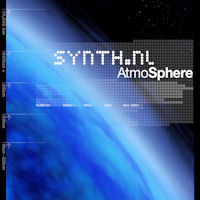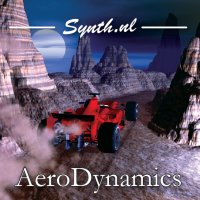
Yesterday I finished another Oakley module. This time an module called 'Discontinuity'. Basically it is a Voltage Controlled Wave Folder. It changes the shape of the signal you put into it and it generally creates overtones. I will show you later with some examples. Almost all the parameters are also voltage controlled which makes it possible as well to keep a sound continuously moving. In the picture you can see the module from the back. As you can see there is a seperate PCB again for the potmeters and jacks. But on this picture the jacks are not installed yet.

And here is a picture of the finished module. Here you can also see the extra PCB with the jacks. I chose to hard wire all the connections between the PCB's. You could also use connectors so that you can take it apart easily, but I didn't see the added value in that. First of all I don't plan to take it apart. The PCB is even reachable from the back in case of a problem. Secondly I don't like putting these kind of connectors on wires. As you can see I wired the most right set of wires a bit too short. I couldn't even put a tie wrap around them anymore. But I decided to leave it this way, because it will work fine and desoldering will make more of a mess I guess.

And then it was time for some testing and calibrating. First the usual smoke test with no problems. Then I put a signal on this input from the PC Function Generator and tested if I heard something on the output. That worked fine. Then I tested the CV inputs and actually got three of them that didn't work. I started investigating by measuring on the PCB and found out quickly that I forgot to wire three wires :) Well keep reading that documentation sometimes ;) After I installed them I even found out that two of them were the wrong way around. And after I twisted that It all looked OK.

After that you really need an oscilloscope to do the calibrating. In the picture on the right you can see an example of what it looked like when I put a triangle on the input and twiddled around a bit. I will do another post later on with some more examples so you can see what it can do. I have a speaker on the output all the time and you can really hear the difference. Normally a triangle sounds very soft just like a sine wave. After putting it through this unit it really sharpens up the sound and you can make some interesting stuff from very basic waveforms. OK. As promised more later. But for now it seems to work fine :)
 Yesterday I finished another Oakley module. This time an module called 'Discontinuity'. Basically it is a Voltage Controlled Wave Folder. It changes the shape of the signal you put into it and it generally creates overtones. I will show you later with some examples. Almost all the parameters are also voltage controlled which makes it possible as well to keep a sound continuously moving. In the picture you can see the module from the back. As you can see there is a seperate PCB again for the potmeters and jacks. But on this picture the jacks are not installed yet.
Yesterday I finished another Oakley module. This time an module called 'Discontinuity'. Basically it is a Voltage Controlled Wave Folder. It changes the shape of the signal you put into it and it generally creates overtones. I will show you later with some examples. Almost all the parameters are also voltage controlled which makes it possible as well to keep a sound continuously moving. In the picture you can see the module from the back. As you can see there is a seperate PCB again for the potmeters and jacks. But on this picture the jacks are not installed yet. And here is a picture of the finished module. Here you can also see the extra PCB with the jacks. I chose to hard wire all the connections between the PCB's. You could also use connectors so that you can take it apart easily, but I didn't see the added value in that. First of all I don't plan to take it apart. The PCB is even reachable from the back in case of a problem. Secondly I don't like putting these kind of connectors on wires. As you can see I wired the most right set of wires a bit too short. I couldn't even put a tie wrap around them anymore. But I decided to leave it this way, because it will work fine and desoldering will make more of a mess I guess.
And here is a picture of the finished module. Here you can also see the extra PCB with the jacks. I chose to hard wire all the connections between the PCB's. You could also use connectors so that you can take it apart easily, but I didn't see the added value in that. First of all I don't plan to take it apart. The PCB is even reachable from the back in case of a problem. Secondly I don't like putting these kind of connectors on wires. As you can see I wired the most right set of wires a bit too short. I couldn't even put a tie wrap around them anymore. But I decided to leave it this way, because it will work fine and desoldering will make more of a mess I guess. And then it was time for some testing and calibrating. First the usual smoke test with no problems. Then I put a signal on this input from the PC Function Generator and tested if I heard something on the output. That worked fine. Then I tested the CV inputs and actually got three of them that didn't work. I started investigating by measuring on the PCB and found out quickly that I forgot to wire three wires :) Well keep reading that documentation sometimes ;) After I installed them I even found out that two of them were the wrong way around. And after I twisted that It all looked OK.
And then it was time for some testing and calibrating. First the usual smoke test with no problems. Then I put a signal on this input from the PC Function Generator and tested if I heard something on the output. That worked fine. Then I tested the CV inputs and actually got three of them that didn't work. I started investigating by measuring on the PCB and found out quickly that I forgot to wire three wires :) Well keep reading that documentation sometimes ;) After I installed them I even found out that two of them were the wrong way around. And after I twisted that It all looked OK. After that you really need an oscilloscope to do the calibrating. In the picture on the right you can see an example of what it looked like when I put a triangle on the input and twiddled around a bit. I will do another post later on with some more examples so you can see what it can do. I have a speaker on the output all the time and you can really hear the difference. Normally a triangle sounds very soft just like a sine wave. After putting it through this unit it really sharpens up the sound and you can make some interesting stuff from very basic waveforms. OK. As promised more later. But for now it seems to work fine :)
After that you really need an oscilloscope to do the calibrating. In the picture on the right you can see an example of what it looked like when I put a triangle on the input and twiddled around a bit. I will do another post later on with some more examples so you can see what it can do. I have a speaker on the output all the time and you can really hear the difference. Normally a triangle sounds very soft just like a sine wave. After putting it through this unit it really sharpens up the sound and you can make some interesting stuff from very basic waveforms. OK. As promised more later. But for now it seems to work fine :)










No comments:
Post a Comment